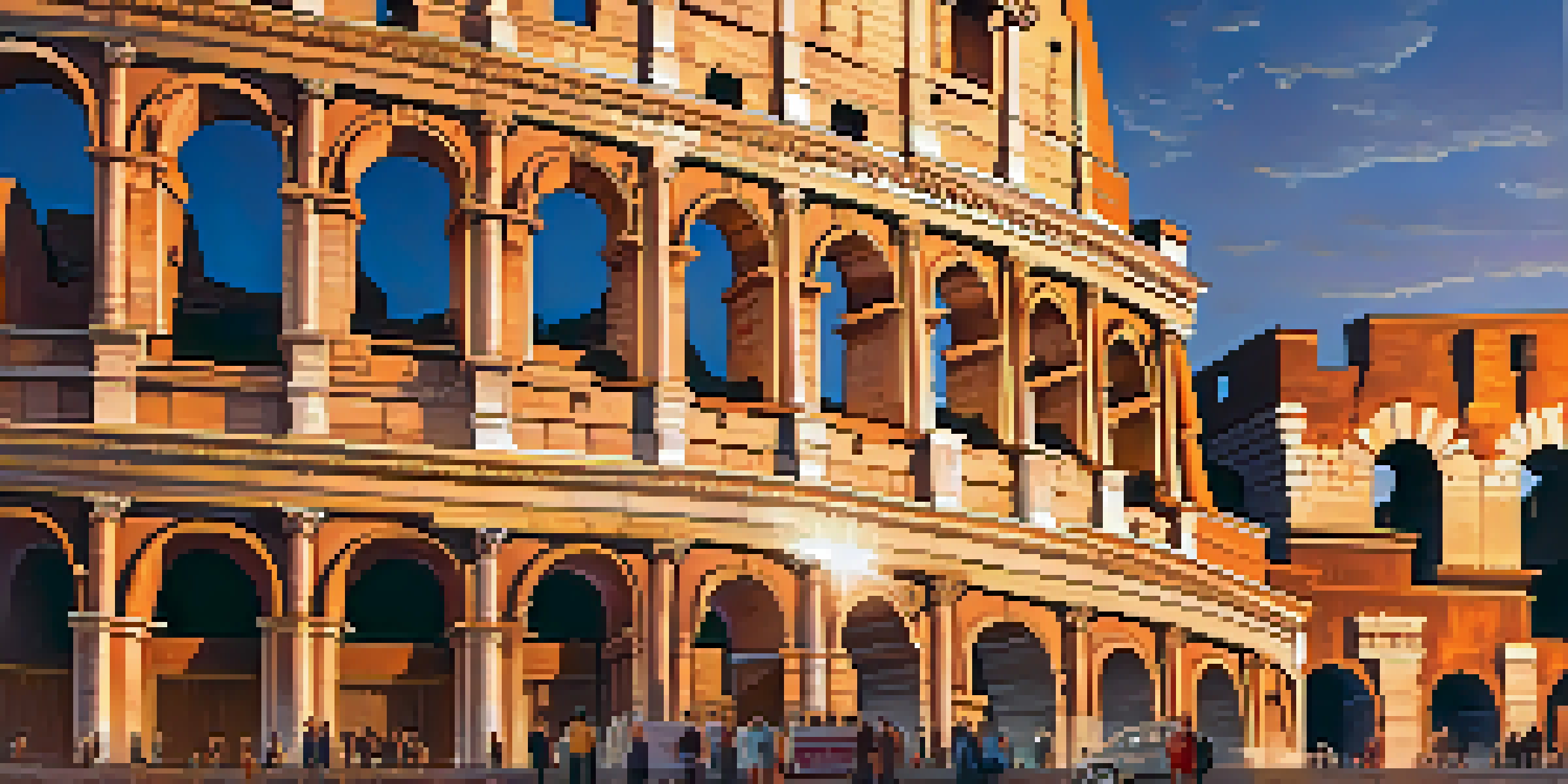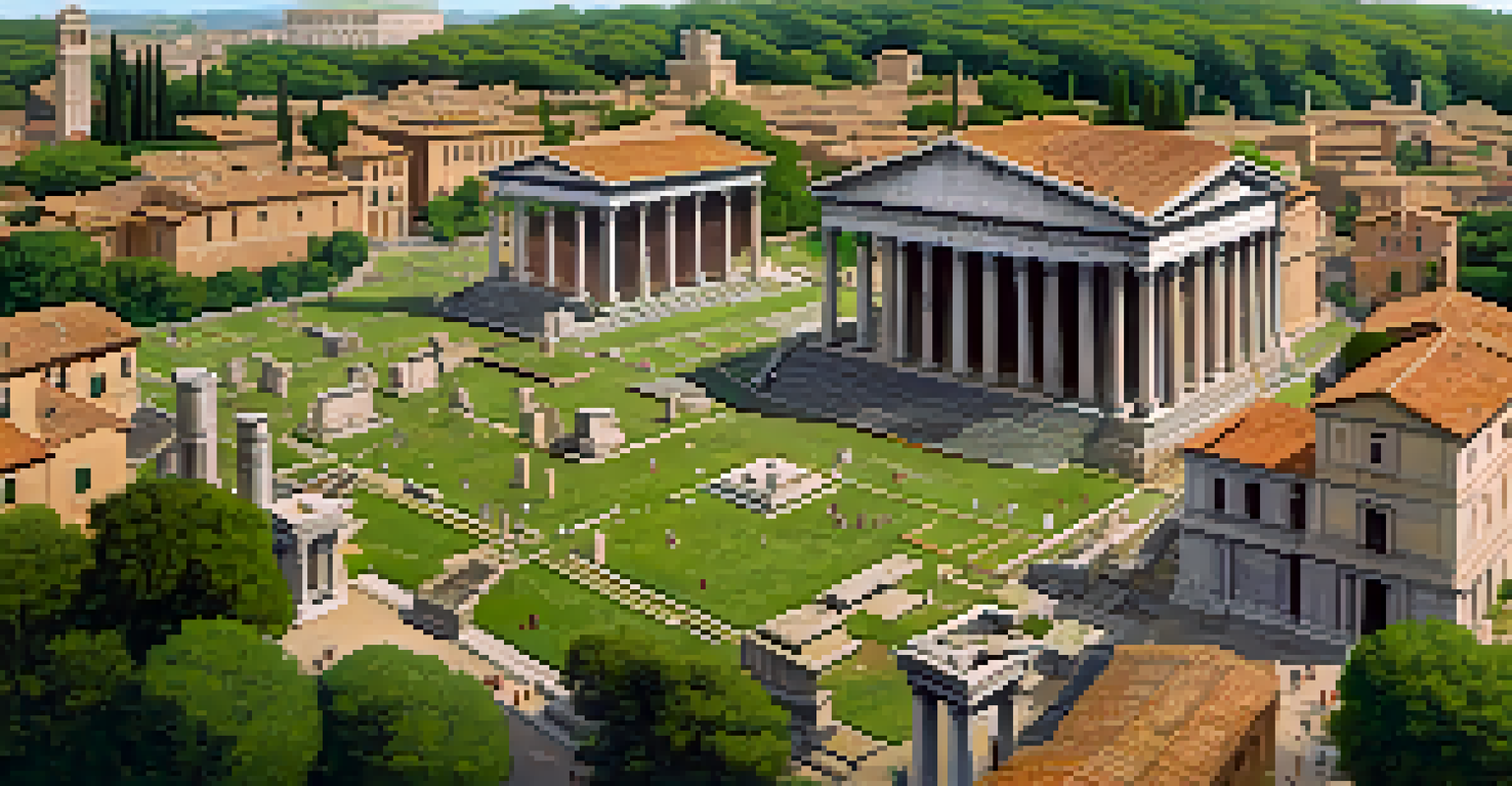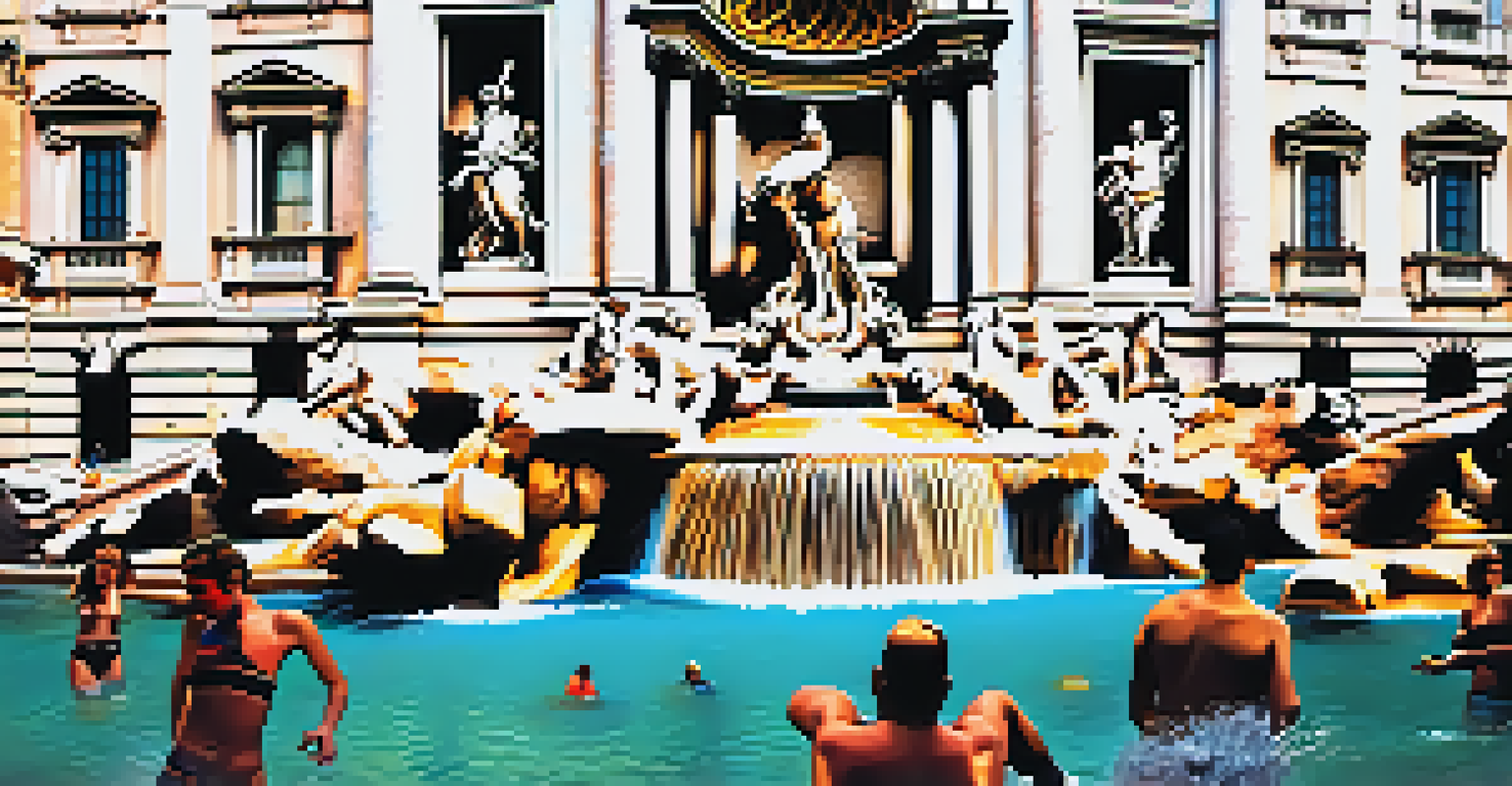Exploring Ancient Rome: A Journey Through Its Historic Ruins

The Glory of the Colosseum: Rome's Iconic Arena
The Colosseum, an architectural marvel, stands as a testament to the grandeur of Ancient Rome. Completed in AD 80, this massive amphitheater could hold up to 80,000 spectators, showcasing epic gladiatorial battles and public spectacles. Imagine the roar of the crowd as warriors fought for glory in the arena, a thrilling experience that captivated the masses.
All roads lead to Rome.
Today, the Colosseum is not just a tourist attraction but a symbol of Rome's rich history. Its crumbling walls tell tales of blood, sweat, and triumph, making it a must-visit site for anyone exploring the Eternal City. When you walk through its arches, you can almost hear the echoes of history reverberating around you.
Visiting the Colosseum offers a glimpse into the past, where the Roman Empire's ambitions came alive. Guided tours often reveal fascinating facts about its construction and the events that took place here, enriching your understanding of this ancient wonder.
The Roman Forum: Heart of Ancient Political Life
Once the center of Roman public life, the Roman Forum is a sprawling complex of ruins that narrates the story of a civilization. Here, politicians debated, citizens gathered, and religious ceremonies unfolded, making it the epicenter of social and political activity. Walking through its remnants, you can almost visualize bustling crowds and hear the fervent speeches echoing in the air.

Among the ruins, structures like the Senate House and the Temple of Saturn stand in silent testimony to their former glory. Each column and stone tells a story of power, democracy, and the daily lives of Romans. It's a reminder of how these ancient people shaped the world we live in today.
Ancient Rome's Architectural Marvels
The Colosseum, Pantheon, and other iconic sites showcase the ingenuity and grandeur of Roman engineering and design.
Exploring the Forum allows you to connect with history on a personal level. As you stroll through, take a moment to reflect on the philosophical discussions that took place here, and consider how these ideas continue to influence modern governance.
The Pantheon: A Marvel of Ancient Engineering
The Pantheon, originally built as a temple for Roman gods, is an architectural wonder that has stood the test of time. Its massive dome, featuring a central oculus, remains the largest unreinforced concrete dome in the world. Standing beneath it, you can't help but feel awed by the ingenuity of Roman engineering and the dedication of its builders.
Rome wasn't built in a day.
As you enter the Pantheon, the light streaming through the oculus creates a divine atmosphere, illuminating the stunning marble interiors. This harmonious blend of space and light evokes a sense of tranquility, inviting visitors to pause and reflect on the divine and the human experience alike.
Now a church, the Pantheon continues to play an essential role in Roman life, hosting weddings and religious ceremonies. Its enduring presence serves as a bridge between ancient and modern Rome, reminding us of the city's rich spiritual heritage.
The Appian Way: The Road to Ancient Rome
The Appian Way, or Via Appia, is one of the oldest and most important roads of ancient Rome, stretching over 350 miles. Known as the 'Queen of Roads,' it was a vital route for military and trade purposes, connecting Rome to the southern regions of Italy. Walking along its ancient stones, you can almost feel the footsteps of Roman soldiers and traders who traveled this path centuries ago.
As you explore the Appian Way, you'll encounter fascinating ruins, including ancient tombs and villas that offer insight into the lives of the Romans. The road is lined with lush landscapes and historical landmarks, making it a picturesque journey through time.
Cultural Significance of Ruins
Landmarks like the Roman Forum and Palatine Hill reflect the complex social and political life of Ancient Rome.
Biking or walking along this historic route allows for a unique experience, where the beauty of nature meets the echoes of history. It’s a perfect way to connect with the spirit of Ancient Rome while enjoying the tranquility of the countryside.
The Palatine Hill: Birthplace of Rome
Palatine Hill, one of the seven hills of Rome, holds a special place in the city's mythology as the legendary birthplace of Romulus, the founder of Rome. This historic site is not only rich in legend but also home to the ruins of ancient palaces, making it a fascinating blend of myth and history. Walking along the pathways, you can imagine the opulence that once graced these grounds.
The views from Palatine Hill are breathtaking, offering a panoramic glimpse of the Roman Forum and the Circus Maximus below. This vantage point allows you to appreciate the strategic significance of the hill in the heart of ancient Rome, where power and wealth once resided.
Exploring Palatine Hill gives you a deeper understanding of Rome's social hierarchy and political dynamics. The remnants of imperial palaces speak to the ambition of its rulers, inviting you to reflect on the city's evolution through the ages.
The Baths of Caracalla: A Retreat for the Masses
The Baths of Caracalla were once a magnificent complex offering relaxation, socialization, and entertainment to the Roman populace. These grand public baths featured not only hot and cold pools but also gymnasiums and gardens, making them a hub of social life in ancient Rome. Imagine the laughter and chatter of citizens enjoying their leisure time in these luxurious surroundings.
Despite their ruins, the scale and design of the Baths still impress visitors today. The intricate mosaics and towering walls hint at the grandeur of what was once a vibrant community space. Each corner of the baths tells a story of daily life and the importance of social interaction in Roman culture.
Timeless Lessons from History
The experiences and ideas rooted in Ancient Roman civilization continue to influence modern culture and governance.
Visiting the Baths of Caracalla is like stepping back in time, where you can almost visualize the Romans indulging in their daily routines. It serves as a reminder of the significance of community and relaxation in a bustling society.
The Trevi Fountain: A Baroque Masterpiece
The Trevi Fountain is a stunning example of Baroque architecture and one of Rome's most famous landmarks. Completed in 1762, this ornate fountain captures the imagination of visitors with its intricate sculptures and flowing water. Tossing a coin into the fountain is a popular tradition, symbolizing a wish to return to Rome, reinforcing the city's enchanting allure.
As you stand before the fountain, the sound of cascading water and the sight of the statues create a mesmerizing ambiance. It’s a perfect spot to pause, reflect, and soak in the beauty of this artistic masterpiece. The combination of art and nature here invites you to experience a moment of serenity amidst the city's hustle and bustle.

The Trevi Fountain also reflects the history of Rome's aqueducts, which once supplied the city with water. Its grandeur is a reminder of Rome's engineering prowess and artistic vision, making it a must-see for anyone exploring this ancient city.
Final Thoughts: The Timeless Allure of Ancient Rome
Exploring the historic ruins of Ancient Rome is like embarking on a journey through time, where each site tells a unique story. From the Colosseum to the Trevi Fountain, these landmarks offer a glimpse into the grandeur and complexity of Roman civilization. As you wander through these ruins, you’ll find yourself enveloped in the spirit of a city that has influenced cultures for millennia.
As you reflect on your journey, consider how the lessons of Ancient Rome continue to resonate today. The ideas of democracy, architecture, and art that emerged from this remarkable civilization have left an indelible mark on the world. The ruins serve as a reminder of the achievements and challenges of a society that shaped the course of history.
Whether you’re a history buff, an architecture enthusiast, or a curious traveler, the ruins of Ancient Rome offer a rich tapestry of experiences. Each visit is an opportunity to connect with the past and appreciate the timeless allure of this extraordinary city.